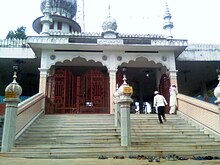Lutfullah Shirazi – Wikipedia
From Wikipedia, the free encyclopedia
|
Lutfullah Khan Shirazi |
|
|---|---|
| In office 1656–1658 |
|
| Monarch | Shah Jahan |
| Governor | Shah Shuja |
| Preceded by | Noorullah Khan Herati |
| Succeeded by | Unknown |
| In office 1658–1663 |
|
| Monarch | Aurangzeb |
| Governor | Mir Jumla II |
| Preceded by | Sultan Nazar |
| Succeeded by | Isfandiyar Beg |
| Children | Motiullah Khan (son) |
| Relatives | Sunarful (descendant) |
Mīr Lutfullāh Khān Bahādur Shirāzī (Persian: مير لطف الله خان بهادر شيرازي, Bengali: মীর লুৎফুল্লাহ খান বাহাদুর শিরাজী, Meitei: ꯃꯤꯔ ꯂꯨꯠꯐꯨꯜꯂꯥꯍ ꯈꯥꯟ ꯕꯍꯥꯗꯨꯔ ꯁꯤꯔꯥꯖꯤ), was a Mughal official who held a number of positions during his life such as the Faujdar of Shujabad Sarkar from 1656 to 1658 and the faujdar of Sylhet Sarkar up until 1663.
Background and origin[edit]

Shirazi was of Persian descent, originally from the Iranian city of Shiraz.[1]

Documents show that Shirazi was a commander for the Subahdar of Bengal, Shah Shuja. He succeeded Noorullah Khan Herati as Faujdar of Shujabad Sarkar (Kamrup region) in 1656. In 1657, Shirazi built the hilltop mosque at Hajo, known as Powa-Makkah Barmaqam. It contained the shrine of Ghiyath ad-Din Awliya, an Iraqi prince and preacher commonly credited for introducing Islam to the region.[2] Shirazi was a disciple of Shah Syed Niamatullah of Karnal and he was visited by the Shah in this mosque according to inscriptions.[3][4]
As Mir Jumla’s invasion of Assam commenced, Shirazi fled from Guwahati to Dhaka in 1658 after the Ahoms and the Koch Biharis rebelled, being led by their rulers Supangmung and Pran Narayan respectively. In Dhaka, he was then appointed the faujdar of Sylhet Sarkar and migrated there, replacing Sultan Nazar. In 1660, he established a strong enclosure in Shah Jalal’s dargah in Sylhet town and also built a small mosque next to it. The Persian inscription stating this is still in existence today.[5][6]
He granted Pandit Raghunath Bisharad of Shamshernagar three and a half haals of land in Ita Pargana in 1663.[7][8]
Sunarphool was a member of Shirazi’s family .[9] During the reign of King Paikhomba (r.1666–1697) of nearby Manipur, a Muslim nobleman called Muhammad Sani presented gold and elephants to the King in return that he allows more Muslims to reside in his kingdom. The king accepted, and Sunarphool moved to Manipur on Muhammad Sani’s request where he lived for the rest of his life. The Pangals that belong to the Makak Angouba clan are descendants of Lutfullah Shirazi through Sunarphool.[10]
See also[edit]
References[edit]
- ^ Chatterjee, Indrani (Spring 2017). “Response to Philippe Ramirez” (PDF). European Bulletin of Himalayan Research: 155. Archived (PDF) from the original on 2020-01-10. Retrieved 2019-12-19.
- ^ Goswami, Māmaṇi Raẏachama (2002). “Down Memory Lane”. An Unfinished Autobiography. p. 67.
- ^ Hanif, N. (2000), Biographical Encyclopaedia of Sufis: South Asia, p. 289
- ^ Balakrishnan, Srinivasan. “The Masjid atop the mountain”. Tripura Chronicle. Archived from the original on 2020-09-05. Retrieved 2019-12-19.
- ^ Chowdhury, Mujibur Rahman (2 Oct 2019). “গৌড়-বঙ্গে মুসলিম বিজয় এবং সুফি-সাধকদের কথা”. Sylheter Dak. Archived from the original on 5 October 2019. Retrieved 19 December 2019.
- ^ Jobrul Alom Shumon (25 August 2015). “ইতিহাস ঐতিহ্যে আমাদের সিলেট-পর্ব ০৫” [The tradition and history of our Sylhet – Part 03] (in Bengali). SBDNews24.com. Archived from the original on 27 May 2019. Retrieved 1 May 2019.
- ^ Syed Mohammad Ali. “A chronology of Muslim faujdars of Sylhet”. The Proceedings Of The All Pakistan History Conference. Vol. 1. Karachi: Pakistan Historical Society. pp. 275–284.
- ^ Choudhury, Achyut Charan (2000) [1910]. Srihatter Itibritta: Purbangsho. Kolkata: Kotha. Archived from the original on 2020-07-12. Retrieved 2019-12-20.
- ^ Makhjummayum, Imam Khan (16 Dec 2009). “Evolution of kinship and clan system among Manipuri Muslim”. The Sangai Express. Archived from the original on 10 August 2019. Retrieved 19 December 2019.
- ^ Khan, Md. Chingiz (2014), “Socio-Cultural And Religious Facets Of Manipuri Muslims During The 17th And 18th Centuries”, International Journal of Research (IJR), New Delhi: IJR, 1 (8): 119, ISSN 2348-6848

Our servers are currently under maintenance or experiencing a technical problem.
Please try again in a few minutes.
See the error message at the bottom of this page for more information.
Recent Comments